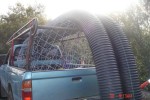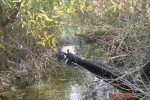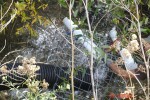Every now and then someone asks me what Worth A Dam does. Do we rehabilitate beavers like the Aspen Valley Sanctuary? Do we reintroduce them like Yakima? Do we install flow devices like Beaver Solutions? And of course the answer is “No, we don’t do any of those things.” But we are extremely busy all the time. How is that possible?
I like to think that what we do, maybe better than anyone else in the world, is cross pollinate beaver information from one place to the next like a giant bumblebee. So that people that never would have connected suddenly realize they have something in common. The festival is just on example of this – and it turns out it all matters way more than you might think. Let me show you what I mean.
My name is Michelle Rogers. I am an Environmental Engineer with the Phillips 66 Refinery in Rodeo, CA. Our Carbon Plant has an access road that is now flooded because of a beaver dam. The dam is in the Rodeo Creek which runs along-side highway 4. I saw the story about the Martinez Beavers and I would like to do something similar with this beaver dam. I want to deal with this issue in a humane way, as I am a big animal lover and I do not want any harm to come to the beavers.
Is there any way that you can point me in the right direction or let me know the steps that you took with your problem in Martinez? Thanks so much and I look forward to hearing from you.
Michelle Rogers
Environmental Engineer
Phillips 66 Rodeo Refinery
It was January 24th. 2014 when I got this email from Michelle Rogers the Environmental Engineer from Phillips 66 in Rodeo. They had some beavers in their creek that were flooding out a service road and they wanted to fix the problem. But rather than trap them, Michelle had heard of the solution in Martinez and wanted to see if it would be possible for them.
The first thing we did was send Jon to the site to walk around with her and understand the problem. He identified the issue and another dam they hadn’t even seen. He showed her where a flow device would probably work and gave her a copy of Mike’s DVD. Michelle took the information (and several articles I armed her with) to her bosses and started talking about what could be done. Then, you might remember, I went in the hospital and we forgot all about it for a while.
Which was just as well because it was months later she was able to get her employers to consider this and she asked me about who could do the work. I introduced her to Kevin, associated with OAEC who trained with Mike Callahan last year and worked with Sherri Tippie this year.
Holy Cow! Heidi, thanks sooo much for passing her along. I’m headed down to check out the dam this afternoon, and can’t wait to see what our favorite critters are up to. Really appreciate all you’re doing, and am super excited about this next project. Please let me know if there’s anything I can do for you as well.
Kevin Swift
Head Beaver, Swift Water Design
So Kevin came out and brainstormed with Michelle and had Sherry Guzzi of the Sierra Wildlife Coalition design a map of what was needed. Then Michelle took that plan to get permission from the county of Rodeo (which is unincorporated) for the work. It was harder than you think. The county supervisors told her that in order to install a flow device she would need an insurance rider protecting Rodeo if anything went wrong. Seriously.
Then I met Fran T. de Sousa.
“We talked at the Beaver festival and you said that if I emailed you you could send me what you have on the Phillips 66 Environmental Dept. guy who called you in for a consult and that he called Skip Lisle about putting in a flow device. I was hoping to get something environmental going for kids in Rodeo and the beavers..and follow Worth A Dam’s lead.Rodeo is unincorporated and it must be county people insisting on insurance. I will get on that right away Thank you so much, I am looking forward to hearing from you!
I still don’t know what Fran does or how she knew what to do, but she was on a first name basis with all of the supervisors and I introduced her to Michelle and she went to work. I never heard another peep about the issue which seemed to evaporate like morning mist. But then there was Fish and Game Wildlife.
When Michelle presented her plan they came and visited the site and saw Western Pond turtles in the creek (species of special concern) and he told her the refinery needed a qualified biologist to come out, ID the turtles and say how the population would be protected from dangerous flow device injuries. Or something like that.
So I introduced her to Kelly, who introduced her to Jeff of the Wildlife Project.
I have copied Jeff Alvarez on this email. He is very familiar with western pond turtles and can either do the work you are looking for, or, if it doesn’t fit into his schedule, suggest someone who can help. He is the Principal Investigator for our western pond turtle telemetry study in Moorhen Marsh. Like Heidi said, the two turtles are easy to tell apart, but you really should have someone out there who knows how to find turtles and determine if you have a population of pond turtles or not. My guess is that if you saw 3 turtles you probably have more than that on site. Let me know if I can do anything else to help. Thanks. – Kelly
Kelly Davidson
District Biologist
Mt. View Sanitary District
Meanwhile the Fish and Wildlife officer told her that in order to install the flow device they’d need a permit to Alter the Stream, which was a little like requiring the EPA to approve which side of the street you park on. I asked Mike, Skip and Sherry if they ever needed to get a permit like this and they all said “Never”. Then I asked whether Martinez needed such a permit 8 years ago, and was told “Never”. I guess I was feeling kind of feisty that Friday, because I just called the officer up to talk about it.
I introduced myself as an interested party, then suggested he come to Martinez and see our flow device for himself. It would help to understand how it didn’t alter the stream bed. He said knew all about them but it was the stakes holding the pipe down that affected stream flow. I said, I appreciate so much your talking to me about this, but do you mean if I was going to build a doc for my canoe I’d need a permit to alter the stream bed? He said it depended on the size of the doc and the area. I said it was really important to consider the precedent he was setting since flow devices were getting to be more common all across the state. He said every region makes its own independent decisions. I said installing a flow device altered the stream MUCH less than removing a beaver dam. He said he agreed, he actually liked beavers, but the key issue here was the turtles. They might get stuck in the pipe which would get full of sediment.
!!!
I assured him that we had western pond turtles in Martinez and in 8 years not a single turtle had ever gotten stuck in the pipe. We said our friendly goodbyes, and then I asked Mike about it who wrote back that in a decade of opening and repairing flow devices he had never seen one retain sediment (or turtles for that matter). I sent his comments along to the officer.
There was a very long silence. Then on October 29th. 9 months and 4 days after Michelle’s initial email, I got this.
We installed our device today. FINALLY!! I wanted to thank you for all the help you gave me. I could not have done it without your help. I wanted your photo person to shoot pictures but was advised not to because of the area we were working in. There is only one parking spot and the large coke trucks are in and out of that area on a consistent basis.
I took pictures. I am attaching a couple of them. If you want to see all of them, let me know. Thank you again for all the help. I am really excited about this!!!
We are excited too, Michelle! and so impressed at your vision in wanting to do this different from the very start. 9 months to save some beavers is a full-term effort. We were beyond delighted to help along the way. I’m sure there were Herculean labors by Michelle and others that I know nothing about, and I thank you for those, one and all!
Somewhere in Rodeo there is a family of beavers that can all grow up in peace. And you know what I think about their ancestry. A short swim down the carquinez strait will take you to Rodeo Creek and I think our dispersers explored their way into Phillips 66. After all, they were used to living near the Shell refinery. It probably looked like home.
Thanks to everyone who helped out on this journey and to everyone who keeps this Worth-A-Dam Bumble Bee flying. Buzz on team beaver!

he author of this article, Michael Runtz, is a friend to wildlife and to beavers in particular. We’ve connected in the past and corresponded about his work. He’s been photographing and watching beavers for 20 years, and his lovely photos were featured in the recent beaver documentary on PBS. The last I heard from him his book on beavers was due out any minute. But I guess while we wait for that we should savor this interesting fact.
 This is the Elihu Harris building in downtown Oakland. It houses some of the most essential state government offices, like the Equalization board, the Alcohol and Tobacco board, The Unemployment board, and the Water Quality control board. That’s where Ann Riley works as a Watershed Stream Protection Advisor.
This is the Elihu Harris building in downtown Oakland. It houses some of the most essential state government offices, like the Equalization board, the Alcohol and Tobacco board, The Unemployment board, and the Water Quality control board. That’s where Ann Riley works as a Watershed Stream Protection Advisor.



















































